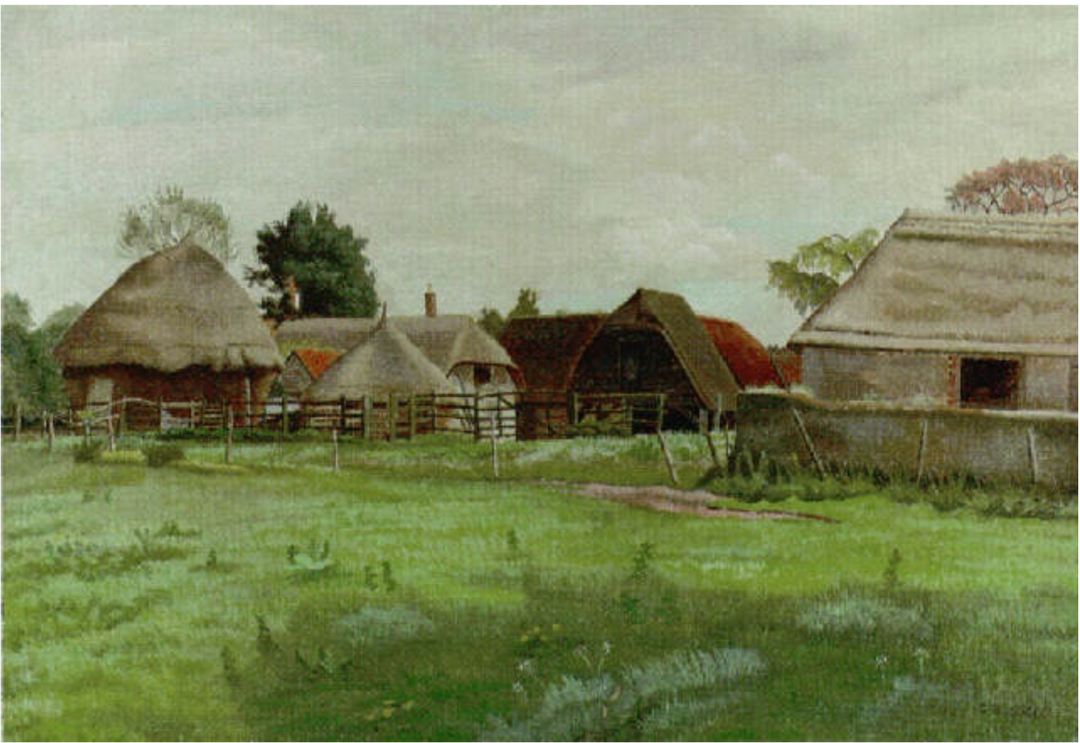Gilbert Spencer was at heart a countryman. He had a deep but unromanticised affinity with rural life, and a familiarity and fascination with the processes and infrastructure of farming. This was born of personal experience, helping out on various farms, as well as close observation. It was thus natural that farms and farming should feature in many of his paintings and drawings, as he travelled around the English counties. These agricultural scenes, particularly those of farmyards, are among Spencer’s finest works.
Possibly the first work Gilbert ever sold was of an agricultural subject, Feeding Pigs (1913, Aberdeen Art Gallery), a small pen and ink drawing made shortly after he entered the Slade, and purchased by Edward Marsh. In depicting this quotidian task, and subsequent paintings such as The Sheep Pen (1925, untraced), Shutting up the Geese (c. 1929, untraced) and Chicken Boy (1931, Leamington Spa Art Gallery and Museum), he drew on his experiences of ‘my regular employment helping at that time on the farm’.
Spencer’s peripatetic existence provided plenty of fodder for his agricultural paintings. Besides his home county of Berkshire, he sought out farms on annual painting holidays near Stourpaine in Dorset in the early 1920s, in the villages around Abingdon, Oxfordshire in the 1920s and 1930s, and in and around Garsington while lodging there in the mid 1920s. Each summer from 1932 to 1945, Spencer and his wife Ursula rented Burden’s Farmhouse near Twyford, Dorset, which consequently featured in many works.
Some of these farm paintings were essentially agricultural landscapes, but Spencer also developed a particular specialism in farmyards. Indeed, a hand-drawn receipt in the Gilbert Spencer archive proclaimed ‘FARM SCEANS [sic] A SPECIALITY’. The earliest of these, A Berkshire Farm (1921, private collection), continued in the vein of his pre-war Slade composition, The Seven Ages of Man (1913/4, Art Gallery of Hamilton, Ontario), with the farmyard principally serving as a foil to the figures. Remove the foreground figures, however, and all the essentials of a Spencer farmyard are there: clapboard barns, accurately-depicted wagons, implements and animals. Throughout the 1920s and 1930s, he repeatedly explored these elements, sometimes focusing on buildings (Barn at Wootton, 1925, private collection), more often on wagons and farm machinery (Oxfordshire Wagon, c. 1924-8, private collection). He painted the latter with a seasoned eye and skilled hand, having spent his childhood making models of farm carts at the kitchen table.
These farmyard paintings would reach their apotheosis in A Cotswold Farm (1930-1, Tate), Spencer’s greatest and most critically acclaimed work. This imaginative composition presided over Spencer’s solo show at the Goupil Gallery in February 1932, winning high praise from the critics, and for the first time, Stanley Spencer felt the sting of being ‘brothered of’ his more talked-about sibling.
The theme of agricultural development would later provide the material for two history paintings, rare in Gilbert’s oeuvre, The Tolpuddle Martyrs (1943, untraced, preparatory watercolour 1937-8, Tate) and The Progress of Husbandry (c. 1964, Tate). A final word must be given to his mastery of painting animals. Although rarely the focus of his compositions, they are invariably portrayed with sharp-eyed humour, from the cocksure cockerels of A Cotswold Farm to the gloating pheasants of The Converted Poacher (1942, private collection).








